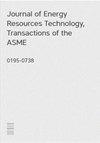Effect of vibration and pressure on the air-bioCNG mixture inside the manifolds of dual-fuel diesel engines
IF 2.4
3区 工程技术
Q3 ENERGY & FUELS
Journal of Energy Resources Technology-transactions of The Asme
Pub Date : 2023-02-06
DOI:10.1115/1.4056842
引用次数: 0
Abstract
The vibration generated by diesel engines may influence air and gaseous fuel mixing in dual-fuel mode. This study is performed on the manifolds of single and twin-cylinder engines in diesel-bioCNG dual-fuel mode. It examines the effect of the engine vibration and variable manifold pressure on the flow behaviour of the air-bioCNG mixture. The objective is to observe the flow inside the manifolds and mixture quality at the outlet. The mentioned work has found little attention till date. The computational comparison of the flow characteristics inside the intake manifold of the single-cylinder engine is done for an F-shape manifold of the twin-cylinder engine during suction stroke. The experiments are conducted to record both the engines' vibration signature and cycle data. For this, the same operating parameters are maintained: compression ratio of 16.5, engine speed of 1500 rpm, engine load range (0 Nm to 34 Nm) and 80% bioCNG substitution. It employs the boundary conditions, such as the vibration amplitude along three axes, variable manifold pressure, and the mass flow rates of air and bioCNG. The parameters to analyse the mixture flow are pressure, velocity, turbulence, helicity and mass fraction of CH4. The mixture at the manifold outlet of the single-cylinder engine improved to average uniformity index of 0.9924, indicating better homogeneity. Further, the manifold of twin-cylinder engine attained the indexes of 0.1484 and 0.2401 for its two cylinders, showing non-homogeneity.振动和压力对双燃料柴油机歧管内空气-生物柴油混合气的影响
柴油机在双燃料模式下产生的振动会影响空气和气体燃料的混合。在柴油-生物燃料双燃料模式下,对单缸和双缸发动机的歧管进行了研究。它考察了发动机振动和可变歧管压力对空气-生物燃料混合气体流动特性的影响。目的是观察歧管内的流动和出口的混合物质量。到目前为止,上述工作还没有得到多少关注。以双缸发动机f形歧管为研究对象,对单缸发动机进气歧管吸入行程内的流动特性进行了计算比较。实验记录了发动机的振动特征和循环数据。为此,保持相同的运行参数:压缩比为16.5,发动机转速为1500转/分,发动机负载范围(0 Nm至34 Nm), 80%的生物燃料替代。它采用了沿三轴振动幅值、可变流形压力、空气和生物燃料的质量流量等边界条件。分析混合物流动的参数有压力、速度、湍流度、螺旋度和CH4质量分数。单缸发动机歧管出口混合气均匀性指数平均提高到0.9924,均匀性较好。此外,双缸发动机歧管的两缸指标分别为0.1484和0.2401,表现出非均匀性。
本文章由计算机程序翻译,如有差异,请以英文原文为准。
求助全文
约1分钟内获得全文
求助全文
来源期刊
CiteScore
6.40
自引率
30.00%
发文量
213
审稿时长
4.5 months
期刊介绍:
Specific areas of importance including, but not limited to: Fundamentals of thermodynamics such as energy, entropy and exergy, laws of thermodynamics; Thermoeconomics; Alternative and renewable energy sources; Internal combustion engines; (Geo) thermal energy storage and conversion systems; Fundamental combustion of fuels; Energy resource recovery from biomass and solid wastes; Carbon capture; Land and offshore wells drilling; Production and reservoir engineering;, Economics of energy resource exploitation

 求助内容:
求助内容: 应助结果提醒方式:
应助结果提醒方式:


